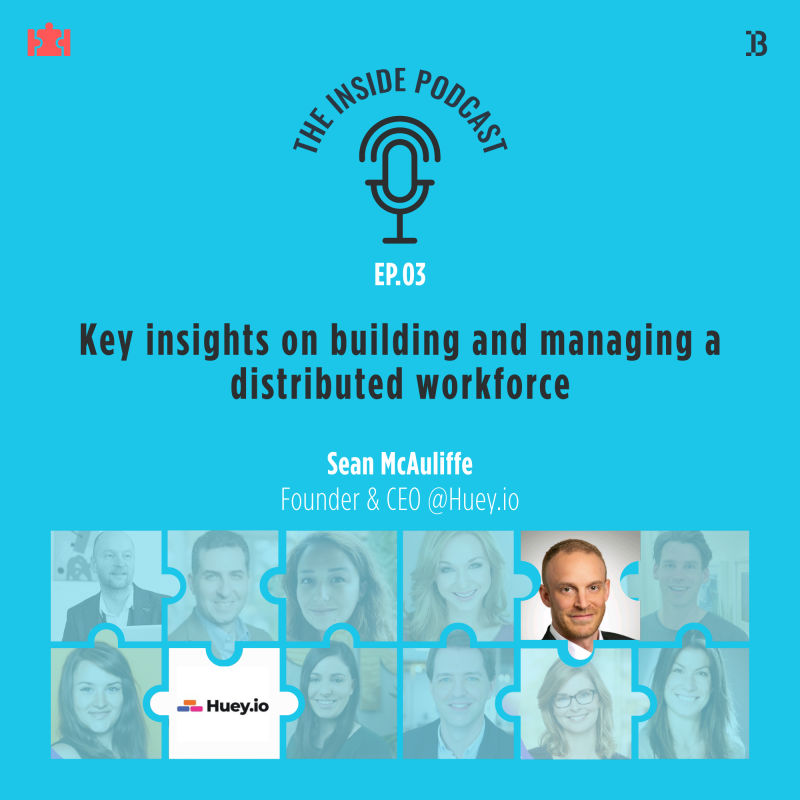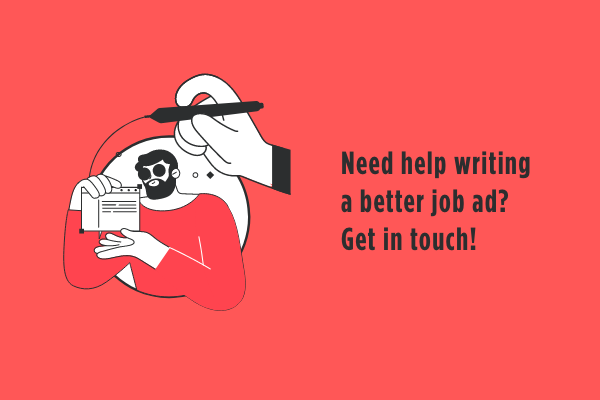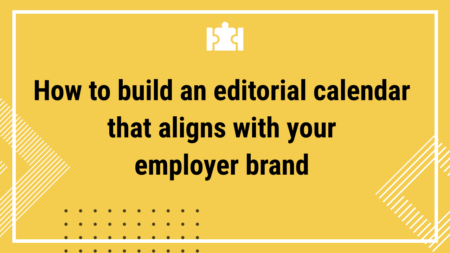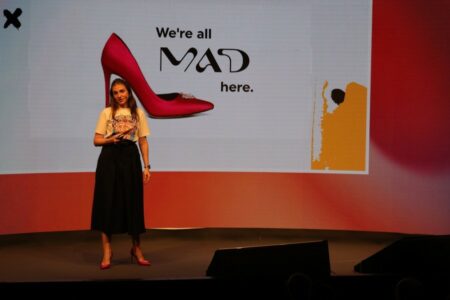Overview
Episode 3 of Employer Branding: The Inside Podcast is up and steaming! Tune in to listen to Sean McAuliffe, Founder & CEO at Huey.io, talk about keeping teams agile when working remotely. Throughout the podcast, we covered several other interesting topics on maintaining balance between people and processes, managing a team through mergers and acquisitions, and a lot more.
What you’ll learn by listening
- People come first in a remote environment: managing distributed teams
- Maintaining balance between processes and people
- Essential tips for managers working with a remote team
- Managing a team through mergers and acquisitions
- The importance of having a strong employer brand when working remotely
- Keeping teams agile as you grow in a remote environment
About the company
Huey is a modern org chart builder that integrates with Slack. Its aim is to address the painful reality of working in an agile environment – the struggle for clarity. Employees need access and understanding about their organization, but it isn’t easy when they don’t know what role each person plays or where that person fits into the bigger picture at any given moment.
It can be exhausting trying to figure out how all these separate pieces come together as part of some cohesive whole! With Huey, employees and managers alike can access and search the org chart by skill, department, name, location, and more, all from within Slack. Provide clarity and streamline workflow with Huey.io
Enjoy listening to S03Ep03 of Employer Branding: The Inside Podcast!
Podcast transcription
Georgiana: Hello, everyone! This is another episode of Employer Branding: The Inside Podcast. I’m Georgiana and today I’m talking to Sean McAuliffe. Welcome, Sean! So good to see you and hear you actually today.
Sean McAuliffe: Yeah, likewise, Georgiana! Thanks for having me on the show. I’m really excited.
Georgiana: Absolutely. And actually, Sean is the CEO of huey.io; a company that’s based in America, which works with people spread out the entire country. But please, Sean, maybe you can quickly introduce yourself and tell us what Huey does.
Sean McAuliffe: Sure, yeah, my name is Sean McAuliffe. I previously founded another company and went through a bunch of mergers and acquisitions, and from there, there was just a lot of frustration, going through that process. All of a sudden you go from 40 people to 120-200, something. It can be very difficult to manage. That’s what inspired me to create Huey. So Huey is basically interactive org chart software, that’s really meant for not only managers to use, but really for employees to use; so they can easily find who they need within the company, really right at your fingertips rather than maybe spend an hour to solve a 10 minute problem, as you might have in the past. I was kind of inspired by some of my own frustrations, and I’m hoping to solve a pain point in modern business.
Georgiana: Well, just so our guests know, this podcast talks mainly about company culture, and maintaining company culture while working remotely. So then, the first question that I’d like to ask is, what is it like to manage a team that’s distributed all across the States? How can you as management, make sure that people, you know, still come first in this remote environment?
Sean McAuliffe: Yeah, definitely. It can be difficult. I mean probably the difference here versus a lot of European countries is the time zones, which sounds minor. But we have three time zones. The West Coast can be three hours different from the East Coast. And that’s something that you really have to consider to put an example out there.
We had a sales manager who was on the West Coast, we were an East Coast business. And most of the people he managed were on the East Coast or in Central. So sometimes it could create some difficulties. It’s not that you can’t make it work. But you really just have to be thoughtful about how you structure your day, how people structure their days, to make sure that they’re overlapping when they need to, you know, and can actually connect.
So that’s one of the just kind of real basic complications that we get out here is just that spread of time zone. The other thing is that it’s hard to say, but some people just don’t work well remotely. Like, there’s some people that are great in the office, not great at home, and that’s okay. But you can’t deny that right? You kind of have to say, you have to be upfront and say, either ‘hey, we need to figure something out, because it seems like you’re struggling, right? What can we do to help?’. So there’s just a lot of different things that come into play as you kind of work through this whole remote thing.
Georgiana: And I know, and I imagine, actually, that processes are almost as important as people and as working with people. But I’m wondering, how do you keep a balance between the two: between processes and people?
Sean McAuliffe: Yeah, I mean, it’s kind of hard if you’re going to prioritize one over the other. But kind of going back to my last point, if you’re hiring remotely you want to make sure that the people are gonna do well and thrive in that remote environment. And that they want to be there.
Some people don’t want to work remotely, right? And if the job is remote and they don’t want to do it, don’t try and force it. Because ultimately, it just might not work. But to that degree, I think having a process for whether it’s daily, weekly, bi weekly touch bases and team meetings and, you know, trying to build the culture. Because with that remote thing, it’s kind of difficult to do that and difficult to share it with new hires. And that can only really be done by making sure that you’re connected with those remote people. So there has to be the right people and then process behind it.
Georgiana: What would you see are the two most essential things that a company manager and a team manager needs to know when working with a remote team?
Sean McAuliffe: For example, I started the company, my last company, as a very small side gig, essentially in an apartment. It eventually grew to 40 people. And through that journey, really what I learned, and I think what’s critical is trust; and trusting your people. So, if you’ve hired them to do a job, it doesn’t necessarily mean that you hired them to do it your way.
You’re kind of, you have a goal you want to get there, it doesn’t have to be your path. Trust in their expertise and their skills to make their own path towards the same goal. I think that’s really something that took me a while to learn. But when I did learn that it really helped us scale, and it just helped me as the founder, just enjoy it more. And that’s because I didn’t have to make every decision anymore, I can trust my people to make the decision. So I think that’s really important, as a manager of a company.
In terms a team manager, I think it’s really about staying in touch with your direct reports, it’s easy to kind of get your head down and work. And then a couple of days might go by before you touch base with with one of your team. So I think that’s really important is really just having a good cadence around, keeping in touch, you know, staying a team. And, you know, working to everybody’s strengths.
Georgiana: I totally agree. And I think especially during these very, very difficult and delicate times that we’re living in, right now, it’s so important to have someone to just remember from time to time to ask you, how you’re really doing, and how your day is going if they’re okay with everything that’s happening.
Sean McAuliffe: Yes, exactly. Not every touch base has to be about work. Right? It could just be you know, it should be a lot of times just on a personal level, like you said, with everything that’s been going on over the last couple of years. It’s easy to get lost there.
Georgiana: But I think when the time is really close knit and there’s a healthy company culture there. I think, eventually, the personal note inserts itself, at least a little bit in the conversation at some point.
Sean McAuliffe: Yes, I agree.
Georgiana: Sean, how does one manage a team properly through mergers and acquisitions? I’m really curious, because in my time, as you know, as a student, and during my first job I was working in a pharmaceutical company in Paris called Sanofi, and then they merged with Aventis. And suddenly they were called Sanofi Aventis. And the culture was gone. And I was wondering, what did the management do wrong? I mean, I know Sanofi was a corporation, and probably mergers and acquisitions aren’t exactly the same, but how do you make sure the culture doesn’t dilute in the process?
Sean McAuliffe: Yeah, it’s definitely difficult. I’ve been through two mergers, on a much smaller scale than that, I’m sure. But the culture can be diluted. But also, if it’s done right, you can get new ideas. So it’s possible, it’s very possible that you can benefit both ways. I can give an example, where with the first merger that we went through, the company we merged with was bigger, older, more established, and with more established processes.
And they had core values. We didn’t even have core values listed as a company culture at that point, as this is really early days for us. And one thing that they did or we did together, is we added another core value that our team put in there. So that kind of helped build a cohesive team because now we felt okay, it’s not that they overtook us and now we’re just part of this thing. It’s okay, we’re a new thing together. And we’re taking the best of Company A and the best of Company B, putting it together and hopefully strengthening where we were both weak. Right?
So I think that is definitely possible. And I’ve definitely stories just like yours, where the culture just completely dies. But I think if done, right, if there’s a lot of communication, a lot of open and honest talk, right and clear objectives and goals through whether it’s town hall meetings or like, you know, just get togethers like that where the more information, the better is really kind of what it comes down to.
Georgiana: Yes. Oh, yes, you’re right.
Sean McAuliffe: Yeah, because you find that I think, you know, management probably has known about the merger for a few months, right before it’s announced. So they’ve had time to digest it; they’ve had a few months to kind of understand what’s happening. Whereas once it’s announced to employees, it’s still new for them for a few months. So I think it’s critical in those early days to really just have a lot of communication, a lot of open and honest q&a and things like that. So there’s definitely the chance for dilution. But there’s also a chance where, you know, one plus one equals three type situations.
Georgiana: Absolutely. And I think people are curious by nature, right? They always want to know what’s going to happen next. Where will I be in this new equation? Will I be in a different position? So yes, absolutely. I think transparency and communication would have saved a lot in my personal story. But um, yeah, it’s difficult. And I think the bigger the company, the more difficult it is.
Sean McAuliffe: I agree. 100%.
Georgiana: Sean, how important is a good employer brand for a company that works remotely?
Sean McAuliffe: I think it’s very critical, although the hard part is conveying it. Right? For instance, if you’ve traditionally been an in-person company, it’s much easier to convey your employer brand. Because you’re near each other, you’re talking every day, you’re going through it all together in the same space. Whereas remotely, I feel like it’s a lot more difficult.
So I think time needs to be set aside, to kind of just network internally, you don’t have those, like water cooler moments as many as you would remotely as in person. So you kind of have to force them a little bit, I think. Sometimes it could be, you know, maybe even a bit awkward. If you’re just going to have a zoom call, where you’re just not going to talk about work, right? But I think it’s really important. I think that’s one of the only ways to get that across. And if you don’t get that across, I just don’t think you’ll get buy-in from employees. And you know, obviously, if you don’t get buy-in, then you’re just not, your company’s not running at its full potential.
Georgiana: Right. And, and since you’re the manager of Huey, an organizational chart app, I’d like to know, how can such a tool facilitate teamwork?
Sean McAuliffe: Yeah, so for me, it kind of goes back to what you were saying before; that employees can feel unsure of where they are in a company, especially after a merger or something like that. Or where you just have rapidly growing teams, especially where it’s kind of difficult to keep track of who’s in the company, what do they do? So the idea with the app, it was the result of my own frustration. These things should be at the employee’s fingertips now. Right? You shouldn’t have to really log into another platform just to just find the right people.
With Huey, it works within Slack. Right? That’s where employees are spending a lot of their time, if not all their time these days. So right there you have, someone has an issue, hey, I need to I need to get something sorted out with 401 K. You can easily just search there and find who it is that handles a 401 K, and reach out to them rather than spending an hour trying to do a 10 minute thing. So that was really the idea of trying to keep teams agile, because as you grow it kind of just starts to slow down. I’m not sure if that answers your question directly, but that was kind of the idea behind.
Georgiana: It does. And what I’d also like to know is, which are the main departments that did benefit from this tool?
Sean McAuliffe: Yeah, I think traditionally you think of org chart software as like management’s tool, right?
Georgiana: Or human resources?
Sean McAuliffe: Or human resources. But the way I want to flip that and really make it the employee’s tool, right, everybody’s tool. If you have a complete vision of the company, you’ll feel more attached to it, right? Because it’s completely open.
But especially in the modern world with hybrid and remote work, where you’re not just a desk away, or an office away from the people you need to talk to, it’s more important than ever, than having that kind of quick and easy database of who you work with, what do they do? So that’s really what it was built for. It’s built for managers, of course, to use it and human resources, but really, it’s built for employees; all employees in every department, that’s that was the idea behind it.
Georgiana: Okay, now, I have a question that’s a little bit from a different register. There’s been a lot of talk about what people call ‘The Great Resignation’. And now I’m sort of asking all of my guests, what their take on this concept is. We also wrote a very extensive article, and we published it on our site. But I’m really curious, but what do you think about it?
Sean McAuliffe: Yeah, it’s very interesting to see. Personally, I think what happened is, people were forced to spend a little bit more time at home; or a lot more time at home, really. And most people realized the benefits of seeing their family more, and having a little bit more personal time. And they don’t necessarily want to go back to work above all else.
So I think that if you probably compare companies that have a bit more of an open culture versus a work above all else culture, I would venture to guess that those companies that are a bit more open and have a little bit more flexible, are seeing less of the great resignation, than those that were more kind of hard driving. Of course, you need to temper that to a degree. Work has to happen and things need to get done. And there’s schedules and things that just need to happen.
But I think that what it will ultimately lead to is flexibility to employees; a little bit more understanding that people have personal lives that they want to be a part of. And that’s my take on it. Whether it’s right or wrong, I don’t know. But from my own personal experience, I like seeing my kids more, I like picking them up from school every once in a while. It doesn’t seem that complex to me, but time will tell.
Georgiana: I agree. I think it’s all going to be about balance. I think there will be a new understanding of the concept of work life balance.
Sean McAuliffe: Yeah. And just to expand one more thing, if you think about work 10, 15, 20 years ago, it wasn’t really with you all the time in your pocket, in your cell phone. A giant shift has already happened over the last 20 years. And I think this is really just like a correction back to somewhere between where we were three years ago, and where we were 20 years ago. I don’t need work to consume my life and be answering emails all night long. I feel like it’s probably a bit of a correction there.
Georgiana: Which is, yes, extremely beneficial. Agreed. We’re approaching the end of this episode. So I’d like to know, what is one resource that’s been crucial in your journey so far?
Sean McAuliffe: Yeah, this is something that I only figured out later in my journey. I wish I had figured it out earlier. But really, that was connecting with a peer group outside your organization. Whether you’re a manager or founder, there’s things that you probably want to talk about just to get off your chest or talk through that.
You can’t really talk about inside your company. So it’s just great to have a sounding board of people who are going through similar things to work through whatever it is that you’re dealing with. So it took me a little while to figure that out. But that’s definitely something that I’ve encouraged everyone to do is somehow find a peer group.
And just connect and you can really work through a lot that way. And it really just helps you understand your situation better because when you’re inside of it, it’s hard to see it from the outside perspective. So you got to step outside. And the only way to do that is by kind of talking through it with other people going through similar things.
Georgiana: This is very, very valuable advice. I completely second it. It’s helped me as well, especially when I was starting out. So yes, thank you for it. Really, really useful. Before we end, I still have to ask you one question. I saw your LinkedIn profile. I saw two things, actually, that you have a new baby. Congratulations for that. As nice as new babies are, I still want to know, how come the passion for sports, sports cars, actually. And car racing? Where did it come from?
Sean McAuliffe: Yeah. Really, I think it probably started with my dad. We watched racing together a lot when I was younger. He passed away when I was pretty young. And from there, I just wanted to be a racecar driver for my entire life. I had no history or connection to racing. No one in my family raced. And it was one of these ridiculous goals. And it kind of was the genesis for me even starting my own business. How do I make enough money where I can go drive race cars? Essentially. So yeah, it’s been one of these silly goals you say when you’re a kid. I want to be a racecar driver. But it’s stuck with me and it really helped me find success.
Georgiana: Got it. Sean, how can people reach you?
Sean McAuliffe: I think probably the best way is LinkedIn. That’s probably the best way or they can reach out to me by email sean@huey.io.
Georgiana: Super. Well, it was really nice talking to you today. I wish you good luck in doing what you’re doing with managing your remote team and with growing up as well. It was super nice. Thank you once again, and hope to be in touch soon.
Sean McAuliffe: Thanks Georgiana. I had a great time.
This was Employer Branding: The Inside Podcast. You can find our podcasts on Spotify on Apple podcasts and content on employer branding-related things on employerbranding.tech. Until the next time, stay tuned.







